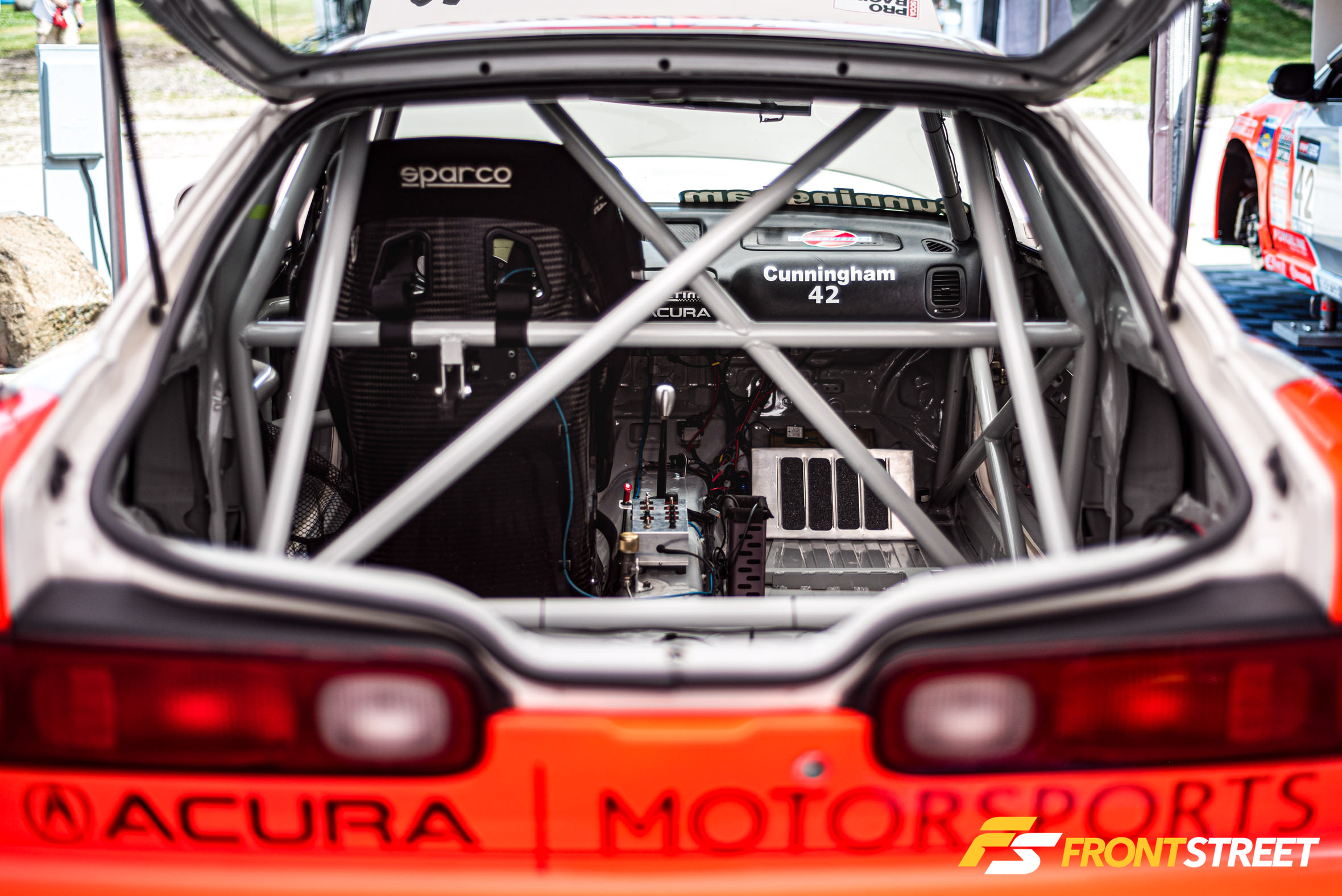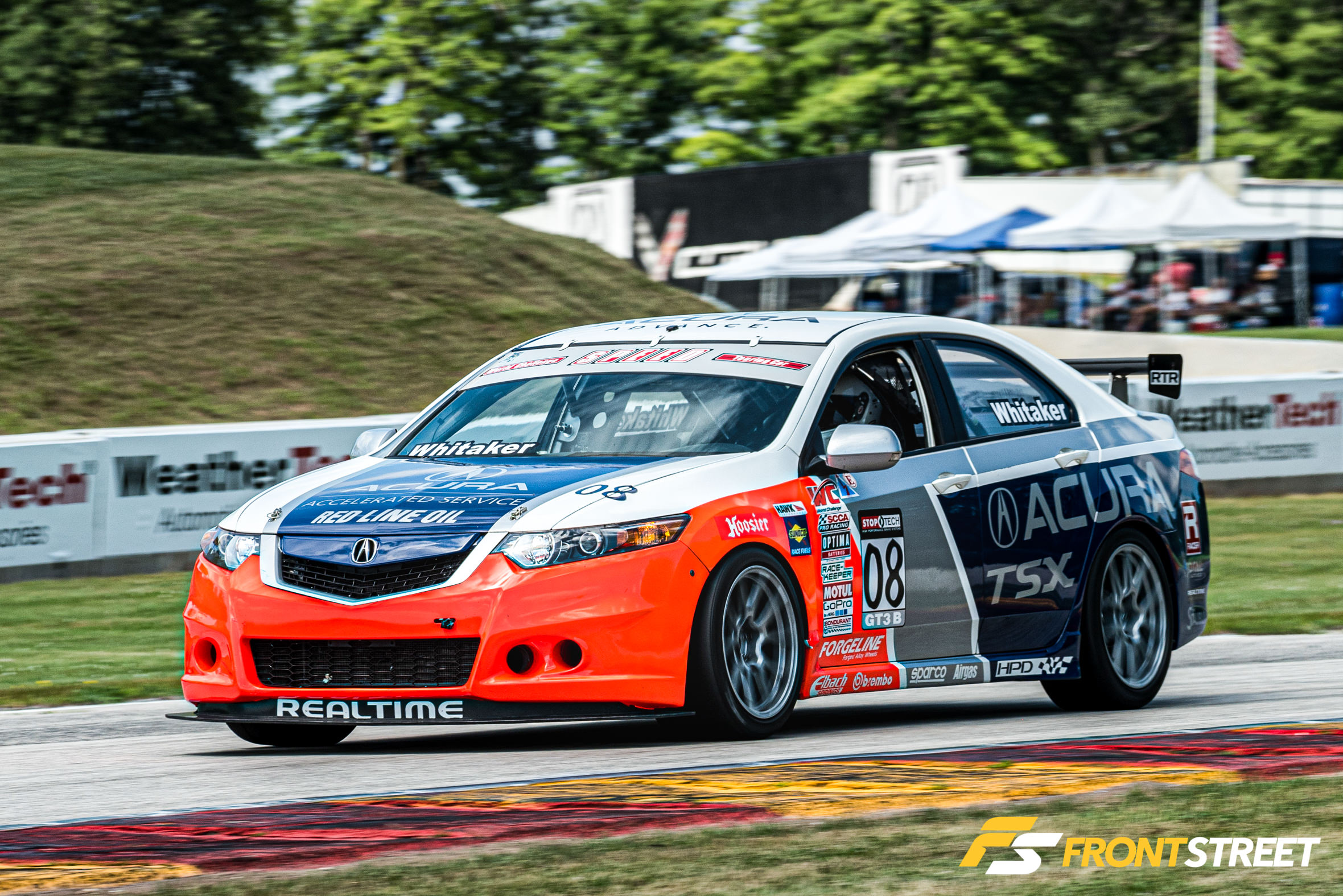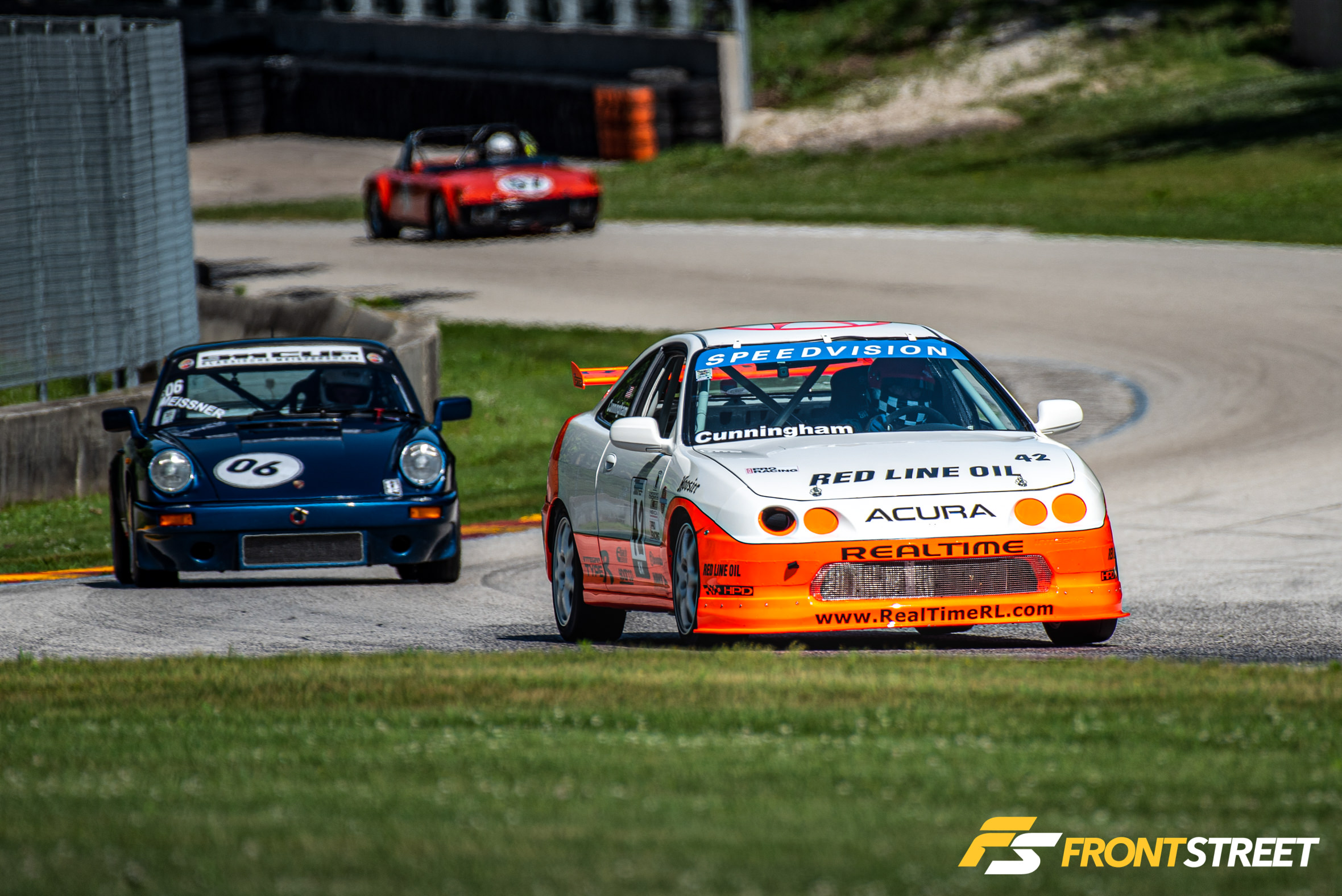
Photography by Jen Muecke (2ndary Highway) / RealTime Racing
If you’re a Honda enthusiast who adored the marque—as I did—throughout the late-‘90s and into the early-‘00s, you currently pay attention to professional GT and hill climb racing, or are well-versed in museum-quality Honda/Acura cars, then one company that needs no introduction is RealTime Racing (RTR).
Peter Cunningham founded the motorsports team outside Milwaukee, Wisconsin, back in 1987, when he won three International Ice Racing Association titles using a group of Hondas ranging from a CRX Si, to a Civic Si, and even a RT4WD Wagon. From there he stepped into continued winning form in the SCCA PRO Rally Series using an Acura Integra GS-R in 1993. However, what most will remember RealTime Racing for—and the subject of today’s article—is the illustrious success of the team in the World Challenge series.
Cunningham piloted a Honda Prelude Si to back-to-back second-place overall finishes in ’93 and ‘94, before winning the series himself in 1995. It wasn’t until 1997 that the renowned white and orange Integra Type R came into play as the new vehicle for RTR’s efforts. The team used these Type Rs to catapult them into utter domination in the World Challenge Touring Car category, winning five championships in six years between 1997 and 2002. This dynasty of RTR victories engraved the Integra Type R into the record books as the most successful car model in the history of the World Challenge Touring Car category. It scored more wins, poles, and championships than any other before, or since!




So what happens when Peter Cunningham and RTR decide to take the famous Integra—and a couple of their TSXs—for a joyride of sorts in the 2019 WeatherTech Invitational Challenge vintage car race?
Well, Peter took time out of his busy schedule to detail the comeback race weekend’s events. We think you’ll like hearing what he had to say, so sit back and enjoy!



Front Street Media: When did the idea to race the Integra and TSXs again initially come to mind?
Peter “PD” Cunningham: Well, when we bought back the Integra in the summer of 2016, we knew that we wanted to restore the car and we didn’t have time to work on it for a couple of years. But then once the restoration process started last fall—as the guys had some free time to work on it—starting then I thought we need to get the thing done and get it out on track. At least to shake it down, showcase that it’s a runner and, you know, let people see it. We didn’t really think that long and hard about it during that process, but as this spring came along and we knew it wouldn’t be ready for the May vintage race, we wanted to try to have it done for the July vintage race. It seemed like it would be done in plenty of time to do that. That was when we started thinking about it like ‘why don’t we take the TSXs out as well?’—because they’re pretty much ready to go.




FSM: How did you find the same Integra again after it changed ownership so many times?
PD: From the Type R community—it was the Integra Type R Club of America at that point because the Civic Type R hadn’t come out yet. So we knew that a friend had it, but he had no intention of selling it. Over the years things changed for him—he is a retired fireman from NY state—and he bought it back from the fourth owner, and those guys had all raced it and crashed it. This guy tried to restore it, and pay homage to the RealTime paint scheme. If you look at his setup, it had an orange pinstripe with the silhouette of what the bottom side of the car being orange looked like, so [it] clearly kind of looked like a RealTime car. He painted the mirrors purple because Hugh Plumb was the last one to drive it for RealTime. He came to us, and said, ‘Okay I’d like to sell the car, I’d like it to be returned to its original home. I’d like to sell it to you.’ So we worked out a price that we both could live with, and I was happy to have it back because you can’t buy provenance. It would have been cheaper just to start with a donor chassis and build it, and paint it to look like it, but you can’t buy the VIN.



FSM: What was the most significant difference since you last drove the Integra around a circuit?
PD: I would say the biggest difference is the tires, because when it last raced we were on Toyo Tires, which were not soft compound race tires. They were more of a street tire. Going to the Hoosier was a big change. But other than that it’s all the same, it’s just not that trick. With the NSX front calipers and OE NSX wheels from the front of an NA2, NSX airbox, there are a number of genuine Acura parts on the car.


FSM: What kind of preparations did you and the RealTime team complete in the time leading up to the historic race this year?
PD: We did a shakedown test on the Thursday before the Vintage weekend with the Integra, because it hadn’t turned a wheel since it was completely rebuilt. We wanted to just see what she would do, and everything worked out pretty well. So, as far as preparations go, just all of the normal details. We aligned the cars, we went through them, nothing out of the ordinary.


FSM: Walk me through your feelings once the Integra and TSXs started their first piece of competition for the weekend.
PD: I felt excited. I felt no pressure of any kind. That’s how I kind of wound down my professional racing career. I didn’t like the pressure that I put on myself, and I had to get up earlier and earlier in the morning to try to beat my own teammate. And so coming to a vintage race, I didn’t have any of that. It was just going to be all fun, so I was excited and eager to get out there. I knew I’d be making a lot of new “friends” out there, especially with the TSX because we were in Group 6, which is the old Corvettes, Mustangs, Camaros, and stuff like that. There was only one guy who turned a faster lap going into the race. Everybody else had similar times to us or slower, but no matter what, they go about a lap a lot differently. They go fast on the straightaway, and then they can’t stop or turn in a 40-acre field—maybe we shouldn’t say that. Haha! Let’s just say they turn a similar time, but they go about it differently.



FSM: Did anything go wrong with the cars throughout the weekend?
PD: In the case of the TSX, there were no issues. It came out of the box and did great. The Integra did have a VTEC issue where it wasn’t engaging; that was one issue we had. There was a little bit of a weird handling issue that we just had to do some sorting with. But really, it just came out of the box and ran great!


FSM: What were the results for each car over the weekend?
PD: The Integra was put into a class called 8X, which is group 8, which is a number of different classes, but the class we should have been in was SSB. In SSB, technically you’re not allowed to have different wings or splitters, so rather than pissing off the regular competitors, we just decided to remove ourselves from that, and they put us in the X class, which is not eligible for awards or podiums or whatever. So the goal was just to beat the entire group, regardless of what class they were in, and not worry about the SSB class—which we had those guys covered.
I don’t know, there were 60-some cars in the group? In the end, we finished fourth overall, but a lot of those cars that were in the top 10, had about 10 mph on us on the straightaways. So for sure, the Integra Type R when it raced back in the day—and even today—Road America is not the best track for that car, because of the three long straightaways, and that car does its lap very differently than the others.
Even in the class that it ran in back in the day, it was always faster under braking and the corners, it wouldn’t always be the fastest car in a straight line compared to the BMWs it was running with. But a 240z won, a 911 was second, a 914/6 was third, and we were fourth overall, then a bunch of 911s and other stuff behind us. Our fastest lap time was 2:35 and some of the cars ahead of us were 1-second, 2-seconds, 3-seconds faster than us, so I was kind of hoping that we could wear them out and hassle them and get by but we never saw them. They were just gone…


But then in the TSX, they split our group because the class I was in was called 10B, which was an eclectic group of 911 Cup cars, and a Ferrari 360 and you can see in the results all of these different cars. So I went on the pole for our class, but Group 6 had a split start so one 427 with a good driver in it was quicker than us, but we were faster than all the other 50-something Group 6 cars there were. They really split us up, so Group 6 was ahead and they got the green flag while we were still in Canada Corner. By the time we took the green, the leaders of Group 6 were already in Turn 5, so they were pretty far up the road.
At the start, a guy in a Porsche kind of drag-raced me into Turn 1, but he braked way early and so I had the corner. Then by the time we got to Turn 5, he was pretty far back, and by the time I looked again, he was gone. So he was not really a factor, but I just put my head down and hauled ass and chased down the Group 6. I had one unimpeded lap, but by Turn 6 on the second lap, I caught the first DFL (Editor’s Note: Dead F***ing Last) driver in Group 6. I had traffic every lap for the next five laps, and then the race was over and we finished 12th overall. But if it had gone even two more corners I would have been tenth overall. To move up from tenth to ninth wouldn’t have been that hard, but then at some point, those other cars were up the road pretty far.
It was a lot of fun, I didn’t hit anybody, and nobody hit me. That was one of the concerns I had coming into the weekend, is I didn’t want to get uninvited to my second vintage race because I pissed off so many people at my first vintage weekend. So I talked to the officials afterward and asked ‘so did my number come up? Were they bitching about me?’ and they were like ‘No. No one complained about you,’ so I guess they’ll invite me back next time.


FSM: What has been your favorite part of this whole vintage racing weekend experience?
PD: I would say interacting with spectators as they saw the cars in the paddock and showed their appreciation and all that. You know, we don’t necessarily do any of it just for them, but it was gratifying that there were so many fans and ‘you know I remember these cars’ and ‘I was in fourth grade, when—‘. Yeah, I love that story! We were a little bit hidden, but we had a number of old cars on display as well, and it was neat to see the 1997 Championship White Integra Type R next to the racecar in Championship White and Acura Motorsports Orange.


FSM: Are there any plans for either car to compete in any other future events?
PD: I would say the Integra we probably wouldn’t take back to Road America. We made it through with all cars completely unscathed—a couple of stone chips is all—and we proved the merit of the Integra. If there was some other vintage race at Blackhawk or some other shorter track, I think that we could really make some hay with it in that type of format. But I would take the TSX back out, as much as it’s a vintage car; it’s only 10 years old. Some of these vintage groups let anybody run.


We at Front Street would just like to thank Peter for taking the time to answer our questions and shed some light on such a momentous vintage racing weekend for Honda/Acura fans all over. If you’re interested in keeping up with the RealTime Racing motorsports program, feel free to check out the links below. We’re working on bringing you some more material from them shortly so stay tuned for that.
https://www.facebook.com/RealTimeRacing/
https://www.instagram.com/realtimeacura/









